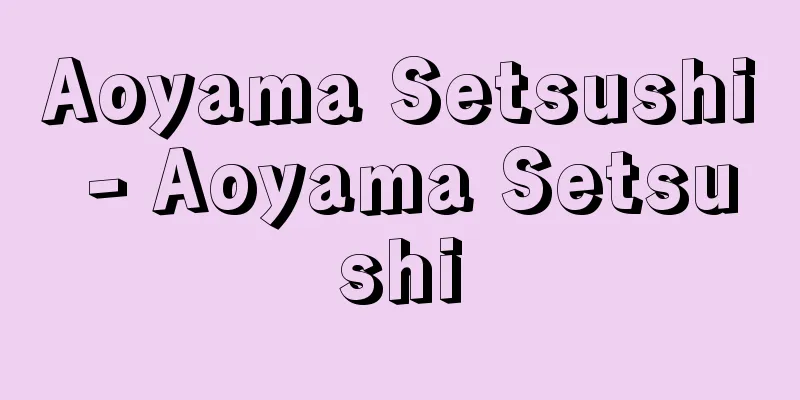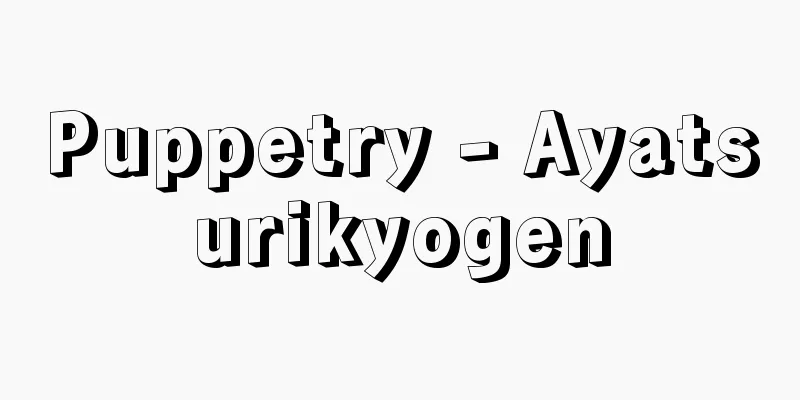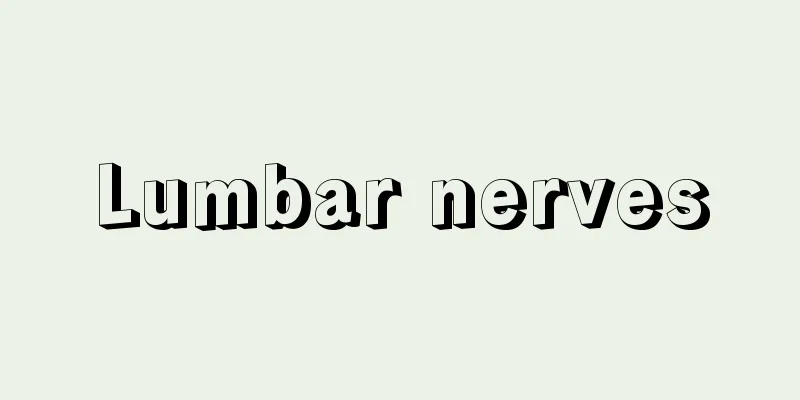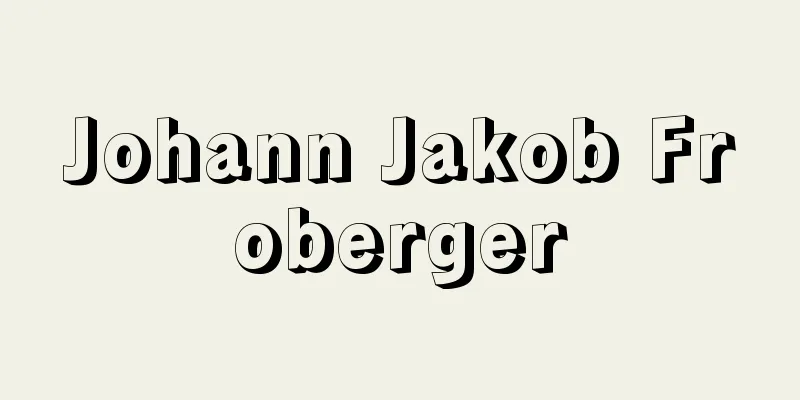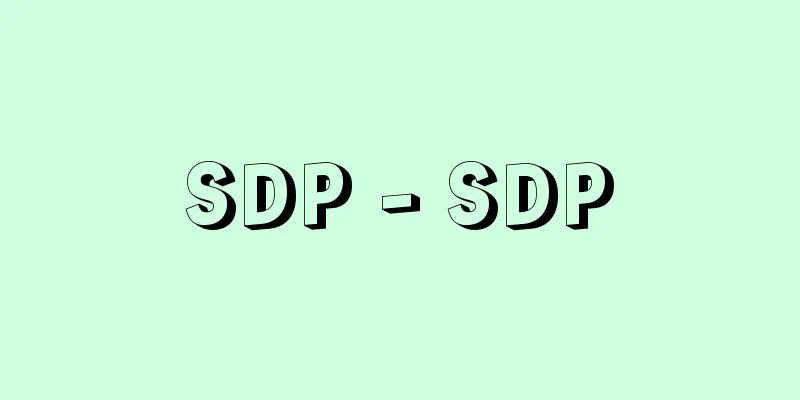Lace - Lace (English spelling)
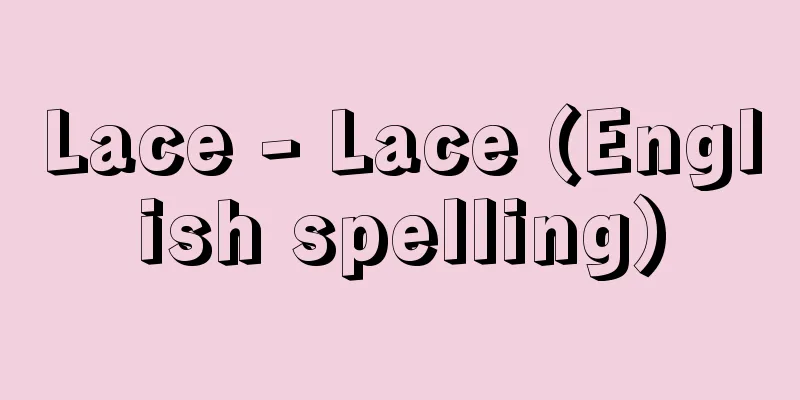
|
Lace is a type of fabric that creates openwork patterns by manipulating threads. Patterns can be complex and diverse depending on the technique and ingenuity used. Embroidery made with openwork patterns on fabric is also called lace. [Shozo Tamura] historyBobbins (spools) with thread wound around them and intricate lace weaving have been discovered in ruins in Egypt and the Inca, and sprang (lace made by twisting thread) has been excavated all over Europe, showing that lace has a long tradition and history. Around the 15th century, it was made as a daily routine for nuns in monasteries, and delicate and gorgeous lace was devised. It was around this time that fillet lace, in which a net is made to fill in the pattern, drawn work, cutwork, and other laces were born. Around the 16th century, interest shifted from luxurious embroidery to simple costumes, and this led to the development of "reticera," in which fabric is cut into square or round corners and sewn with thread, and then "punto inaria," which is not restricted by the fabric, and then needlepoint lace. During the Louis Dynasty in France, luxurious lace became an essential part of royal costumes, and large quantities of lace were required, with men also using lace, so lacemakers in various regions produced unique lace. Lacemaking also spread as a women's hobby, and it can be said that the various lace techniques used today were established around this time. Then the French Revolution occurred, and the demand for lace plummeted, causing lacemakers to lose their jobs, but handmade lace continued as a hobby for women. [Shozo Tamura] Japanese laceIn Japan, lace has been used since the Nara period, when woven fabrics such as ra, ro, and sha were made into costumes and kimonos, and was also used in a small way for decorative knotting in temples and Shippo knotting in horse harnesses. Today's so-called lace was introduced from overseas during the Meiji Restoration, and with the adoption of European-style clothing during the Rokumeikan period and the spread of Western clothing, lacemaking became popular as a form of cultural education for women. Technical books were also imported along with threads and wool, and the delicate style that Japanese people preferred eventually spread nationwide as a home-based craft, to the point where lace was even exported. After World War II, there was a need for knitted fabrics and lace for clothing, and as new threads and materials were developed, lace using the appropriate techniques became popular. [Shozo Tamura] Race TypeNeedlepoint LaceIt is done using a sewing needle, by drawing a pattern on thick paper or stiff fabric, running thread along the outline and fastening it with a different thread. Using that thread as a base, the spaces in the pattern are filled with various types of stitches. Thread is passed between the gaps or edges of the pattern, and the thread is used as a core to connect the pieces (bridge) or fill in the gaps with a ground stitch (ground). Then, a different thread is placed around the outline of the pattern, and buttonhole stitching is done to give it a three-dimensional shape. Finally, the different thread that was fastened to the paper or fabric is cut off to finish the pattern. [Shozo Tamura] Batten laceMachine-made blades (0.5 to 1.0 cm wide) are attached to a pattern drawn on thick paper, the seams of the blades are joined, the gaps in the pattern are filled with stitches, the attached thread is cut, and the piece is removed from the base to complete the process. [Shozo Tamura] Bobbin LaceThis lace is made by crossing and combining threads, and is called bobbin lace because the threads are wound around a bobbin and then manipulated, and also called pillow lace because it is made by pinning the threads to a base (pillow). Even when many threads are used, the threads are manipulated in groups of four. There are only two movements, crossing and twisting, but the shapes and patterns are created by the way the pins are inserted and advanced. [Shozo Tamura] Macramé laceThey are made by tying threads together with the fingertips. The basic knots include a wrap knot, which uses one thread as the core and ties it twice (horizontal wrap knot, diagonal wrap knot), a chain knot, which uses two threads as the core and ties them alternately, and a flat knot, which uses two of the four threads as the core and ties the remaining two alternately. Depending on the application, material, color, etc., there are flat and three-dimensional knots. [Shozo Tamura] Touching RaceThe thread is wound around a shuttle, which is a boat-shaped board 6 to 7 centimeters long, and the thread is passed through the shuttle with the fingertips to create a series of knots using the shuttle thread as the core thread. There are two types of knots: ring knot, in which the shuttle thread is tied in a loop, and bridge knot, in which a separate thread is used to tie the knot. Patterns are created by combining these. [Shozo Tamura] Fillet LaceWind the thread around a netting needle, then wind it around a mesh board (a board used to measure the size of loops) and tie a knot in the front loop. By increasing or decreasing the number of stitches and the size of the loops, patterns and shapes can be created. The net that has been created can also be used as a base to create patterns with embroidery. [Shozo Tamura] Teneriffe RacesThe thread is stretched across a circle or square shape, and then a pattern is created by tying or stitching other threads onto that base. [1] Knitting lace (knitted lace) Continuous loops are knitted with knitting needles, and new loops of yarn are pulled out of each loop with other knitting needles, forming overlapping rows of knitted fabric. Transparent patterns are created by pulling out some loops from the previous row (increasing), combining several loops from the previous row into one (decreasing), and creating new loops (over-stripping). [2] Kunststricken lace: German for "artistic knitting," it was made in Germany and other parts of Europe. In the past, thin yarn was used to knit floral and geometric patterns by increasing and decreasing stitches and overlocking stitches from the center outward. [3] Crochet lace The yarn is left in a loop, and the next loop is pulled out with a crochet or lace stitch, knitting stitch by stitch to form a knitted fabric. There are various techniques, including chain stitch, single crochet, medium long stitch, and long long stitch. There are also patterned knitting techniques that combine these techniques, such as "square stitch," "net stitch," "pineapple stitch," and "cloisonne stitch." There is also "motif stitch," which is knitted mainly from the center and then joined together. [4] Bruegel lace This is made by crocheting a ribbon-like material, bending it according to a pattern, and connecting the gaps. Because of the gentle curves created, it is also called bogen lace (ski marks). [5] Hairpin lace This name comes from the use of hair pins. A stick is set up at a certain width, and thread is wrapped around it while weaving it in the center to create a tape with loops on both sides. [6] Irish Crochet Lace This type was often made in the Irish region of the UK, hence the name. It is made with floral motifs such as roses, grapes, and clovers, and a core thread is inserted to create a three-dimensional shape that stands out. The motif and edges are turned inside out and sewn to the base cloth, and the gap is filled with netting with picots, and then it is removed from the base cloth. [7] Afghan lace This knitting method uses both knitting and crochet techniques, and uses Afghan needles with crochet-like tips. The forward movement creates loops in the same way as the knitting needles, and the backward movement creates stitches one by one in the same way as the crochet hook. An openwork pattern is created by increasing, decreasing and over-crocheting stitches. [Shozo Tamura] Tulle and laceThis lace is made by embroidering machine-made hexagonal mesh (tulle). The mesh has three-way stitches, so turning stitches, buttonhole stitches, backstitches, etc. are used to make the most of this. [Shozo Tamura] Lace weavingLace made on a loom. The warp threads are twisted and then threaded through the weft threads. [Shozo Tamura] Machine RaceWith the invention of the stocking knitting machine by England's William Lee in 1589, the bobbin net machine by England's John Hiscote in 1808, and the embroidery lace machine by Switzerland's Pyleman in 1828, patterned lace with a texture close to that of handmade lace became mass-produced by powered machines.Currently, various laces are made using bobbin lace machines, such as twisted river lace and tulle lace, torsion lace by braiding machines, raschel lace by hosiery machines, embroidered lace by embroidery machines, and chemical lace, in which lace is embroidered onto vinylon fabric and then the fabric is dissolved later to leave only the embroidery thread. [Shozo Tamura] "History and Design of Lace" (1979), edited and published by the Japan Textile Design Center [Reference] |©Shogakukan "> Needlepoint Lace ©Shogakukan "> Bobbin Lace ©Shogakukan "> Macramé lace ©Shogakukan "> Touching Race ©Shogakukan "> Fillet Lace ©Shogakukan "> Batten lace, Teneriffe lace, Tu… Source: Shogakukan Encyclopedia Nipponica About Encyclopedia Nipponica Information | Legend |
|
糸を操作することによって透かし模様をつくりだしたもの。その技術とくふうによって模様は複雑、多様になる。また布地に透かし模様でつくった刺しゅうもレースとよぶ。 [田村彰三] 歴史エジプトやインカの遺跡から、糸を巻いたボビン(糸巻)や精巧なレース織が発見され、欧州各地からスプラング(渡した糸をねじってつくるレース)が発掘されている事実から、古い伝統と歴史をもっていることがわかる。15世紀ごろには修道院の尼僧の日課としてつくられ、繊細で華麗なレース類が考えられた。網地をつくり模様の箇所を埋めるフィレ・レース、ドロンワーク、カットワークなどが生まれたのもこのころである。16世紀ごろになると、豪華な刺しゅうから清楚(せいそ)な衣装へと関心が変わり、布地を四角や丸角に切り取って糸を渡してかがる「レチセラ」、さらに布地に制約されない「プントインアリア」から、ニードルポイント・レースへと発展した。 フランスのルイ王朝では、豪華なレースが宮廷衣装として不可欠のものとなり、男性もレースを使用するなど、大量のものが要求され、各地で独得のレースがレース職人によってつくられた。また、婦人のたしなみとしてレース作りが広まり、現在のレースの諸技法はこのころに確立されたといっていい。やがてフランス革命が起こり、レースの需要は激減してレース職人は失業するが、手作りのレースは婦人の趣味として続けられた。 [田村彰三] 日本のレースわが国のレースは奈良時代ごろから羅(ら)、絽(ろ)、紗(しゃ)などの織物類が装束や着尺としてつくられ、寺院の飾り結び、馬具の七宝結びなど、わずかに使用されている。 現在のいわゆるレース類は、明治の文明開化に伴い外国から伝来したもので、鹿鳴館(ろくめいかん)時代の欧風衣服の使用、洋服の普及とともに、レース編みは婦人の教養として普及した。糸、羊毛などの輸入とともに技術書も輸入され、日本人好みの繊細さが、やがて手内職として全国的に普及、レースを逆に輸出するまでになった。第二次世界大戦後、衣服としての編物、レースが必要となり、新しい糸、素材の開発に伴い、それにあわせた各技法のレースが流行するようになっている。 [田村彰三] レースの種類ニードルポイント・レース縫針を使うもので、厚手の紙または固めの布に模様を描き、輪郭線に糸を沿わせて別糸で留める。その糸を土台にして、模様の空間を種々のかがりで埋める。模様の間や縁との間に糸を渡し、その糸を芯(しん)にしてかがってつないだり(ブリッジ)、地埋めかがりで埋めて(グランド)から、模様の輪郭に別糸をのせ、ボタンホールステッチをして立体的にし、最後に紙または布にとじつけた別糸を切り離して仕上げる。 [田村彰三] バテン・レース厚手の紙に描いた模様にあわせて、機械製のブレード(幅0.5~1.0センチ)をとじつけ、ブレードの合わせ目をつなぎ、模様の空間をかがって埋め、とじつけた糸を切って土台からはずして仕上げる。 [田村彰三] ボビン・レース糸を交差させたり、組み合わせてつくるレースで、糸をボビンに巻いて操作するのでボビン・レースといわれ、また台(ピロー)にピンで留めながらつくるので、ピロー・レースともいわれる。たくさんの糸を使う場合でも、操作する糸は4本を単位にする。動作は渡す(クロス)、ねじる(ツイスト)の二つだけだが、ピンの打ち方、進め方で形や模様がつくられる。 [田村彰三] マクラメ・レース糸を指先で結び合わせてつくる。1本の糸を芯糸にして2回ずつ結ぶ巻き結び(横巻き結び、斜め巻き結び)、2本の糸を交互に芯糸にして結ぶくさり結び、4本の糸の2本を芯糸にして残り2本で交互に結ぶ平結びなどが基本で、その応用や素材の変化、色彩などによって平面のもの、立体のものなどがある。 [田村彰三] タッチング・レース長さ6~7センチメートルの舟型の板をあわせたシャトル(シャットル)に糸を巻き、指先で糸をくぐらせてシャトルの糸を芯糸にした結び目を連続させてつくる。シャトルの糸を輪にして結ぶリング編と、別糸を使って結ぶ2本どり編(ブリッジ編)があり、それを組み合わせて模様をつくる。 [田村彰三] フィレ・レース網針に糸を巻き、目板(ループの大きさを計る板)に糸を巻いて、前段ループに結び目をつくる。目数の増減、ループの大きさなどで模様や形をつくる。また、つくった網を土台にして、刺しゅうで模様を入れる。 [田村彰三] テネリフ・レース円形、四角形などに糸を渡しておき、その糸を土台にして別糸で結んだりかがったりして模様をつくる。 〔1〕ニッティング・レース(棒針編みレース) 棒針で連続したループを編成し、他の棒針でそれぞれのループから新しく糸のループを引き出して、段を重ねて編み地を形成する。前段のループからいくつかのループも引き出す「増目」、前段の数ループを、一つのループにまとめてつくる「減目」、新しくループを作る「かけ目」などによって、透けた模様をつくる。 〔2〕クンスト・ストリッケン・レース ドイツ語で芸術編みのことで、ドイツをはじめヨーロッパ各地でつくられた。昔は細糸で、おもに中心から外側に向けて増減目、かけ目などで、花模様、幾何模様が編まれた。 〔3〕クロッシェ・レース(かぎ針編みレース) 糸を輪の状態にしておき、かぎ針またはレース編みで次のループを引き出して、一目ずつ編成しながら編み地を形成する。鎖編み、細編み、中長編、長編のほか、いろいろの技法がある。それらを組み合わせた模様編み地、「方眼編み」「ネット編み」「パインアップル編み」「七宝編み」などがある。ほかにも、おもに中心から編み始め、つなぎあわせる「モチーフ編み」がある。 〔4〕ブリューゲル・レース かぎ針編みで、テープ状に編みながら、図柄にしたがって曲げたり、間をつないでつくる。ゆるやかなカーブがつくられるので、ボーゲン・レース(スキーのあと)ともいわれている。 〔5〕ヘアピン・レース 髪のピンを使ったので、この名称がある。一定の幅に棒を立て、糸を巻きつけながらその中心で編んで両側にループのあるテープができる。 〔6〕アイリッシュクロッシェ・レース イギリスのアイルランド地方でよくつくられていたので、この名前がある。バラ、ブドウ、クローバーなどの草花をモチーフにして、芯糸を入れて浮き上がるように立体的につくる。台布に、編んだモチーフと縁を裏返しにしてとじつけ、その間をピコット付きのネット編みなどで地埋めをして、台布から外してつくる。 〔7〕アフガン・レース 棒棒編みとかぎ針編みの両方の編み方を使う編み方で、棒針の先がかぎ針状になったアフガン針を使う。往きは棒針と同じようにループをつくり、後戻りでかぎ針と同じ一目ずつ目を形成しながら戻る。増減目かけ目によって、透かし模様をつくる。 [田村彰三] チュール・レース機械製の六角形のメッシュ(チュール)に刺しゅうしてつくるレース。網の目が三方向になるので、それを生かしてターニングステッチ、ボタンホールステッチ、バックステッチなどが使われる。 [田村彰三] レース織織機を使ってつくるレース。経(たて)糸をねじっておき、緯(よこ)糸を通してつくる。 [田村彰三] 機械レース1589年、イギリスのウイリアム・リーの靴下編機、1808年同国ジョン・ヒスコートのボビンネット機、1828年スイスのパイルマンの刺しゅうレース機などが発明され、手作りレースに近い質感をもたせる模様レースが、動力機械によって量産されるようになった。現在では、ボビン・レース機による撚(より)組織のリバー・レース、チュール・レース、また組紐(くみひも)機によるトーション・レース、メリヤス機によるラッセル・レース、刺しゅう機による刺しゅうレースと、ビニロン生地(きじ)に刺しゅうしておき、あとで生地を溶解して刺しゅう糸だけを残すケミカル・レースなどがつくられる。 [田村彰三] 『日本繊維意匠センター編・刊『レースの歴史とデザイン』(1979)』 [参照項目] |©Shogakukan"> ニードルポイント・レース ©Shogakukan"> ボビン・レース ©Shogakukan"> マクラメ・レース ©Shogakukan"> タッチング・レース ©Shogakukan"> フィレ・レース ©Shogakukan"> バテン・レース、テネリフ・レース、チュ… 出典 小学館 日本大百科全書(ニッポニカ)日本大百科全書(ニッポニカ)について 情報 | 凡例 |
>>: Retz, Jean-François-Paul de Gondi, Cardinal de
Recommend
The Documents of Iriki
…He later lectured on Japanese history and Europe...
Adrastos
A hero of Greek mythology, known as the commander ...
Oharagi Dance - Oharagi Dance
This is a dance song that was popular from the end...
Edoardo Chiossone
Italian copperplate engraver. Born in Arenzano ne...
Itosho
A manor in Ito and Shima counties in Chikuzen Prov...
Valentine's Day (English spelling) (St.) Valentine's Day
Valentine is a holiday for the Christian saint Val...
Human trafficking - human trafficking
A human trafficker is someone whose occupation is ...
Kerenyi
Hungarian mythologist. Studied at the universities...
Ambam - Ambam
...It is a yellow hygroscopic crystal that is use...
Morpho sulkowskyi (English spelling) Morphosulkowskyi
…[Mayumi Takahashi]. . . *Some of the terminology...
Cowpox method - Gyutouho
…Then it was reported that an effective method fo...
Meniscus - Meniscus
…The other type is called a synovial joint, in wh...
One-person company
Generally, a company whose equity (shares in a jo...
pit
...The tongue also senses air vibrations, current...
Pil'nyak (English spelling) Boris Andreevich Pil'nyak
Russian and Soviet novelist. His real name was Vo...


